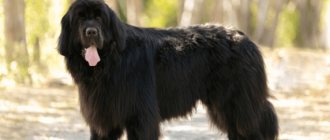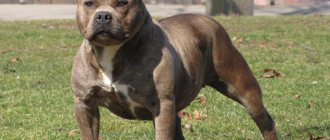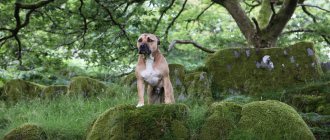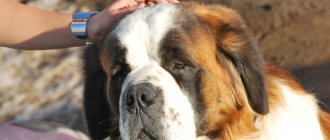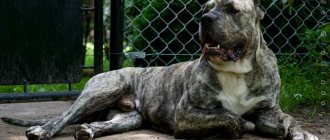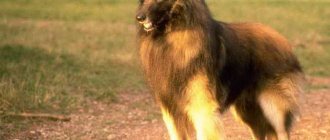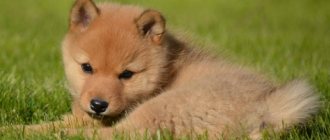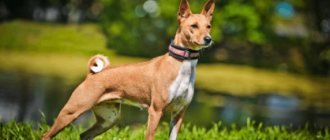/ Dogs / Dog breeds / Finnish Lapphund dog
0
3358
Article rating
Finnish Lapphund, Finnish Lapp Laika, Finnish Lapp Dog - these are all names of the same dog breed. Strong and resilient dogs, they were used for a wide variety of purposes. According to the classification, they are classified as Spitz, and in the north they perform any tasks that are entrusted to dogs. In cities, it is no longer so much a shepherd and sled dog, but a companion, a star of exhibitions and a service dog.
Finnish Lapphund
Story
One of the most ancient species of four-legged friends of man belongs to the northern breeds. The Lapphunds are associated with the now extinct Sami people, who in ancient times inhabited Karelia and Ladoga.
Apparently, these charming creatures in the old days not only kept people company, but also occupied honorable positions in society. Their images can be found on various objects belonging to the shaman, for example, a tambourine. All this indicates an exceptional attitude towards furry creatures in ancient tribes.
It is noteworthy that they sometimes participated in hunting, but at the same time they are not at all aggressive creatures. The northern peoples, unlike European countries, did not engage in hunting animals and did not need fighting dogs either. They were busy with the process of survival and finding a way to make their life easier. At some point they managed to domesticate deer.
This gave many opportunities to people both in terms of speed of movement and quality of food. It was our heroes who occupied the positions of shepherds. They drove the herd into the pens allocated for them, guarded it, and at the same time the rest of the owner’s property.
Breeding the breed in factory conditions began only at the beginning of the twentieth century. The first standards were established in 1945, but at that time the name was different - Lapland Sheepdog . In 1955, the Fédération Cynologique Internationale recognized and registered the breed. Finnish Shepherds can also be called Lapp Laika. Each name is valid and used not only in Finland, but throughout the world. The dogs began to be called by their modern name only in 1993.
Today, Lapphund breeders have not achieved widespread popularity, but their charges are widely known and loved in Norway, Sweden and Karelia.
Feeding Finnish Lapphund dogs
The Finnish Lapphund is not picky when it comes to food, but you still shouldn’t feed it cheap dry food. It is also not recommended to give these dogs too large portions of food. The diet of the Lapp Laika should contain a large amount of animal proteins, but there should be relatively few vegetables. If you feed your dog prepared food, it is advisable to use dry varieties soaked in warm water, or canned dog food. The Lapp Spitz should always have plenty of water.
The Lapphund's diet should consist of raw or lightly boiled meat, boiled porridge, dairy products and some vegetables. The meat should be lean, it is best to choose lamb or beef. Meat accounts for 45-50% of the total serving volume. Buckwheat or rolled oats are chosen from the porridges, and it is better to boil them in meat broth.
Vegetables are given finely chopped, and they make up no more than 10-15% of the portion. Dairy products account for about 20% of the diet. Milk is given only to puppies; adult animals are fed cottage cheese or kefir. The total weight of the daily portion is 400-600 g, and the volume of food is increased for those dogs that undergo intense physical activity.
Standards
The established standards give us the following description of the breed:
- The average height at the withers is about forty-seven centimeters.
- Permissible weight is about twenty kilograms.
- The body shape is square.
- The head is quite large, especially in relation to the body. The forehead is convex. There is a narrowing towards the nose.
- The ears are set wide apart, in the form of small triangles.
- The eyes are slightly elongated. The iris is always dark in color. Brown and black colors are allowed.
- The teeth are straight, white and have a scissor bite.
- The chest is wide.
- The stomach is taut.
- The back is strong and level.
- The limbs are long, straight and parallel to each other.
- The tail is set quite high, of medium length, and abundantly covered with hair.
Our beauties have long and thick fur. Falls in straight strands. The hair on the nose and limbs is much shorter. The undercoat is dense, thick and warm. Only dark colors are allowed as a color. White color is always in the minority. It is usually located on the chest, head, neck, muzzle, paws and tail.
Temperament and use
Finnish Lapphunds are true working dogs, adapted to the most difficult and dangerous work. This dog combines two mutually exclusive instincts - herding and hunting. Working with large and dangerous animals requires strength, dexterity and ingenuity from the dog; courage and willpower are their irreplaceable qualities. The dogs are easy to train and are successful in agility, obedience, and freestyle.
Lapphunds are practically free from genetic diseases. They prefer to live outside even in winter; in apartment conditions they are prone to prolonged molting and lose their spectacular appearance[1].
Description of the breed
This is a very friendly, cheerful, cheerful and active dog. You will never get aggressiveness from him; he would rather try to run away from you than rush in with his teeth bared.
Due to their trusting attitude towards all humanity, Finnish huskies are completely unsuitable for home guarding. It is clear that herding deer is a completely unclaimed activity today, especially in large cities. Therefore, our friends are used only as companions.
This dog is just a fire starter. He can become a cure for any melancholy, a best friend, a family pet, not just a nanny, but a whole team of animators for your child. She is also amazing in her intelligence. She is easy to train, quickly learns and remembers commands, and is capable of making independent decisions. The Shepherd is focused on life with a person, so it does not experience any sense of competition, giving the reins of power into the hands of its owner.
At its core, this is a working breed of dog. They were called upon to help tribes in the most difficult situations. Along with hunting and walking cattle, Lapphunds are also famous for their rescue operations.
Very often they are involved in all kinds of services related to saving lives or search operations. They have excellent data for athletes. For fun, you can practice different games with your pet, such as throwing a stick or playing with a ball. They will also enjoy taking part in dog running competitions.
As rescuers, Lapp Laikas are very functional , because there are no obstacles for them in the form of a snow storm or too low a temperature. They are also often used as companions for people with disabilities.
It's hard to imagine what this dog couldn't handle. If he is entrusted with the protection of the territory, then he will undoubtedly explore it and raise his voice when he discovers someone else, but he may not be able to stand up for himself and for the owner’s property. Although here too there were examples where, with the right approach to training, our comrades turned out to be excellent watchmen.
Character and training
The Finnish Lapphund has a character quite typical of a Spitz - loyal, responsive, person- or family-oriented. In everyday life, the four-legged dog is curious, determined, cheerful and very resilient. At work, representatives of the breed are very vigilant, courageous and tireless. If you manage to watch a dog while grazing, no words about the decorativeness imposed today will no longer matter.
Note! The Finnish Lapphund needs to have responsibilities because he is yearning for work. If you and your pet live in an apartment, you need to be smart. Representatives of the breed are attentive to their work, so they can bring slippers exactly on time, close doors (left open), and keep an eye on (more precisely, “watch”) the children.
In training, the Finnish Lapphund shows very good results. With the right approach from childhood, four-legged animals master not only basic, but also additional commands. If your dog is interested, you can try agility classes with frisbees.
This is interesting! Despite the fact that Finnish Lapphunds have not been used as sled dogs, most of them enjoy sledding children or doing bikejoring.
Representatives of the breed do not need to be trained in guard work; the skills are genetically embedded in them. While on the site, even while resting, the dog constantly monitors its surroundings. Another advantage of the Finnish Lapphund is its comparative silence; if it starts barking, it means there is a reason for it . At an early age, the ward needs to be actively socialized, since by nature, dogs with a good-natured look are not at all kind to strangers. The dog shows particular intolerance towards noisy strangers and those who enter the territory without the knowledge of the owners.
Important! Raising a Finnish Lapphund requires endurance and some experience. Inexperienced owners are fascinated by the dog’s appearance, put up with pranks, and when the pet grows up, they cannot establish the correct hierarchy.
Maintenance and care
You shouldn’t even think about having such a cute pet in your apartment. The point is not even in his size, but in the fact that he is not used to such benefits. Moreover, he doesn't need them. Nature has rewarded him with a warm fur coat, and it should be used for its intended purpose.
At home, shedding continues for too long a period of time, unusual for the breed. And hair loss can result in either severe dermatitis or baldness. So your four-legged friend can only live outside. At best, he will agree, and a cozy, but not insulated booth.
Movement is simply vital for them. Having plenty of space makes them feel better. In the area near your home, they will be able to walk around, explore the secret corners of your yard, and hunt for rodents or birds. They will like this kind of life. Living in a confined space will simply kill the animal.
If you don't have enough space to let your pet out and let him frolic on his own all day, then you will have to find time for independent walks. Try to do this away from the roadway and too crowded streets.
Otherwise, care is not too burdensome for the owner. Check the condition of your teeth, nose, ears and eyes several times a week. Remove dirt with a slightly damp cotton swab. The coat will have to be brushed a couple of times a week. That's all.
Nature has not deprived Lapphunds of health. They are very hardy , patient, resistant to low temperatures and have a good immune system from birth.
But this does not mean at all that they do not need to be vaccinated and undergo preventive medical examinations. Make sure your diet is correct and the food is fresh. They require good nutrition to maintain energy and warmth in any weather. The best decision would be to discuss the daily menu with your veterinarian.
Reproduction and lifespan
For Russia, the breed is considered quite rare; it can be seen only at the largest exhibitions. Therefore, breeding them yourself is difficult and unprofitable. Any owner will try to choose a nursery or breeder for purchase that has long been known and has proven itself well.
However, here is information for general information: the first estrus in females occurs at the age of 12-14 months, and it is better to breed from 2 years on 11-15 days from the beginning of estrus. On day “X” the animals are given a good walk, but there is no need to feed them. They are introduced to each other on neutral territory, allowing them to run around together. Mating is carried out on the territory of the male.
After 1-2 days, a control mating is carried out. Pregnancy lasts 62-67 days. There are 3 to 4 puppies in a litter, which can all be different colors. You need to choose a baby at the age of two months, and be sure to take into account his physical and psychological health. The ears, eyes and nose should be clean, the fur should be smooth and fluffy, with a uniform structure. Behavior is lively and fearless.
Lapphund puppies must undergo socialization so that they do not grow up restless and timid. At an early age, mom does this. As they grow older, the responsibility falls on the owner, in the form of education and training. Once in the house, the dog must understand that he is a member of the family like the others. Life expectancy is 13-14 years.
Finnish Lapphund puppy
Price
The hardest part about purchasing the right Finnish Shepherd puppy for your home is finding a kennel. There are not so many of them on Russian territory. There is a high probability of meeting official breeders in northern Europe. So if you prefer to vacation in those regions, you can immediately give yourself an excellent gift that will stay with you for fourteen years. This is how long representatives of this species of huskies live on average. Depending on your preferences and the puppy's pedigree, it can cost six hundred or seven hundred euros .
Choosing a Finnish Lapphund puppy
At the moment, there are few breeders in Russia engaged in breeding dogs of this breed, so puppies are most often purchased in Finland, the homeland of the breed. Before traveling, it is recommended that you review photos of the puppies and their parents to ensure they meet the breed standard. It is also worth consulting with experienced dog handlers who can recommend a good breeder or a suitable kennel. Here's what dog breeders write about buying a Lapphund puppy:
“A Lapp husky puppy is not cheap. The minimum price translated into Russian rubles rarely falls below 30 thousand rubles. And the elite offspring of show stars cost 60-80 thousand. But if you buy a pet without an elite pedigree, you can keep it to 25-30.”
Owner reviews
Several reviews:
- “I wanted a Husky for a very long time, but friends suggested getting a Lapphund, and I decided to try it. This is an incredible dog. No matter what mood I’m in when I return from work, just by looking at him I start to smile. I can’t even imagine how it was possible to manage without him for so many years.”
- “The Finnish husky is very beautiful, but completely unsuitable for an apartment. This option of keeping a dog turns into torture for both the owners and him. We tried and returned the pet back to the breeders.”
Pros and cons of the CFL
Karelo Finnish Laika or Finnish Spitz is a wonderful animal for living with a person. They are perfect for family life and singles.
Pros:
- Small size;
- Easy care;
- Cheerful and flexible character;
- Excellent working qualities;
- Good nature;
- Mind.
Minuses:
- An active breed that requires constant exercise;
- Increased excitability and emotionality;
- They can howl and bark frequently;
- Classes must be held regularly.
In general, it is a wonderful pet, attached to a person, requiring affection and care.
